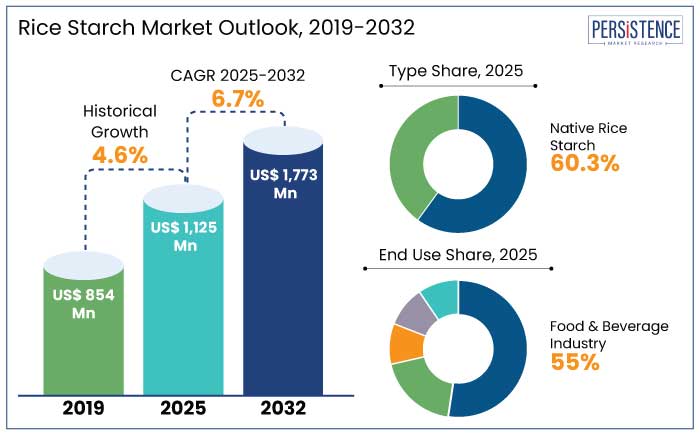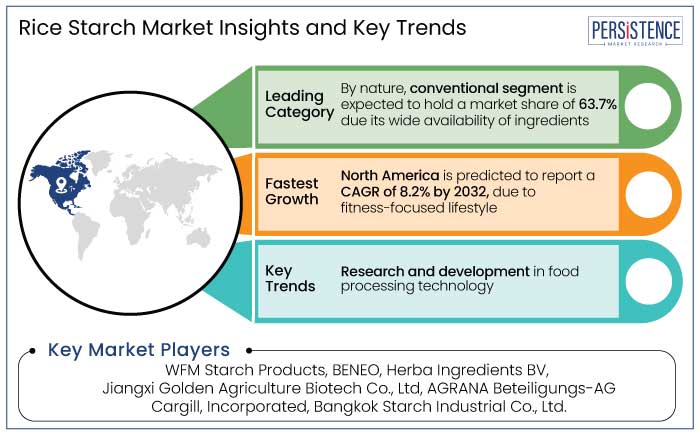Industry: Food and Beverages
Published Date: January-2025
Format: PPT*, PDF, EXCEL
Delivery Timelines: Contact Sales
Number of Pages: 180
Report ID: PMRREP16144
The global rice starch market is estimated to reach a size of US$ 1,125 Mn in 2025. It is predicted to rise at a CAGR of 6.7% through the assessment period to reach a value of US$ 1,773 Mn by 2032.
The demand for rice starch is on the rise due to the growing preference for clean-label and natural food ingredients. This demand is particularly seen in gluten-free products, owing to the rising awareness of gluten sensitivities and celiac disease.
The food and beverage sector, especially in Asia Pacific, utilizes rice starch for its superior texturizing and stabilizing properties. This starch is also used as a binding agent in medicines and as a natural texturizer in cosmetics, highlighting its versatility. For instance, In October 2023, BENEO launched a clean-label rice starch, Remypure S52, tailored for gluten-free baked goods, offering enhanced stability and mouthfeel.
Rising disposable income in emerging economies is fueling the demand for processed foods, boosting growth. Rice starch is a preferred option in several sectors owing to its sustainability and biodegradability.

Key Highlights of the Market
|
Market Attributes |
Key Insights |
|
Rice Starch Market Size (2025E) |
US$ 1,125 Mn |
|
Projected Market Value (2032F) |
US$ 1,773 Mn |
|
Global Market Growth Rate (CAGR 2025 to 2032) |
6.7% |
|
Historical Market Growth Rate (CAGR 2019 to 2023) |
4.6% |
In 2025, North America is projected to hold 29.8% of the global rice starch market share, reflecting its development in gluten-free and clean-label products. The region is forecasted to maintain a CAGR of 8.2% from 2025 to 2032, driven by continued innovation and a heightened focus on health and wellness.
The market is anticipated to witness expansion in North America due to the prevalence of celiac disease and consumer desire for clean-label and gluten-free goods. Innovations in the industry align with the growing trend towards natural and plant-based alternatives, offering safer and sustainable options for consumers with dietary restrictions
The burgeoning food and beverage industry along with the rising health-conscious consumer trends are anticipated to drive growth in Asia Pacific with a projected share of 42% in 2025. The region is anticipated to witness a robust CAGR of 8.5% from 2025 to 2032.
The retail sector for rice starch is witnessing growth in the region owing to rapid urbanization and population expansion in emerging nations like China and India. The starch's natural, gluten-free, and hypoallergenic qualities are driving its demand in the food processing, pharmaceutical, and personal care industries.
In 2025, native rice starch is anticipated to account for a share of 60.3% owing due to its extensive use in gluten-free formulations, functional foods, and sustainable product development. Native rice starch is positioned to take the lead in the global rice starch market because of its low processing costs and sustainability advantages.
Rice starch’s natural qualities make is a popular ingredient in food, medicine, and personal hygiene products. Companies are progressively adopting native rice starch as a clean-label alternative to meet the growing demand for healthier and preservative-free solutions. For instance,
In 2025, the conventional rice starch segment is predicted to dominate the market with a 63.7% share due to its widespread use in processed foods, pharmaceuticals, and cosmetics. Growing consumer demand for clean-label and organic products, particularly in the dairy and baking industries, are driving the appeal of organic rice starch. For instance,
High regulatory focus on sustainable ingredients is set to push demand for organic rice starch to complement conventional offerings.
A naturally occurring polymeric carbohydrate, rice starch is the main component of rice and has a number of useful qualities. Due to closures and interruptions in production, the global pandemic has had a detrimental effect on the rice starch market.
Bioethanol, rice wine, and other useful chemicals can be made from rice starch. It can assist to regulate meat, fish, and vegetables and provides strong water-binding performance at low process temperatures. For example,
New varieties with distinctive qualities and a better understanding of end-use quality factors are likely to spike rice starch consumption.

The global rice starch or thickener industry recorded a decent CAGR of 4.6% during the historical period from 2019 to 2023. Demand for bakery and convenience processed foods drove the demand for rice starch during the period. The food and beverage sector along with the cosmetics and personal care industries also witnessed growth due to the demand for organic food products. For instance,
Thickening ingredients obtained from starch are commonly used to enhance the texture and taste of bakery and dairy products, soups, sauces, and dressings. Demand for rice starches is estimated to record a considerable CAGR of 6.7% during the forecast period between 2025 and 2032.
Rising Trend of Sustainability and Ethical Sourcing to Propel Demand
Consumer preference for sustainably grown and ethically sourced rice is influencing purchasing decisions. Brands emphasizing transparent supply chains are gaining a competitive edge.
Transparent supply chains and sustainable sourcing are gaining traction among consumers. This enables brands to capture a substantial market share and cater to the growing demand for clean-label and socially responsible products.
High Popularity of Vegan Diet to Influence Demand
Modified rice starch is becoming increasingly popular among vegetarians and vegans as a sustainable and adaptable substitute for powdered gelatin. It has a smooth and creamy texture that makes it perfect for plant-based cooking applications like soups and sauces.
It retains beneficial properties such as protein and fiber content, enhancing its appeal among health-conscious consumers. Ingredion launched a range of organic and non-GMO modified rice starch products tailored specifically for vegan and allergen-friendly food formulations.
In response to the increasing demand for natural and plant-based substitutes that satisfy functional and nutritional requirements, Roquette has launched rice starch-based dairy-free fruit products, that guarantee stability and rich tastes.
Price Fluctuation of Raw Materials to Hamper Production
The price volatility of key raw material, the rice, is impacted by consumer demand, weather patterns, and geopolitical events. This presents difficulties for the manufacture of rice starch. Businesses find it challenging to control these outside factors, which lower stability and profitability.
Presence of alternative starch sources such as corn, wheat, and potatoes add another layer of complexity to the situation. Fluctuations in the prices of these alternatives can further impact the demand for rice starch, making it harder for the market to expand.
Supply chain interruptions stemming from various factors can exacerbate these issues, leading to a challenging landscape for rice starch producers trying to maintain a competitive edge in the industry.
Innovations in Food Processing Technology to Create New Prospects
Manufacturers are leveraging advanced processing methods to enhance the quality and usefulness of rice starch. This assists in increasing its use in a variety of sectors while improving its stability, decreased viscosity, and water-binding capability.
Rice starch is now an essential component of non-food products including medications and cosmetics due to improvements in processing, assuring safety and good performance. Its quality and adaptability are maintained by the ongoing development of innovative techniques, which makes it a crucial part of many industrial and functional food items.
Food and Beverage Sector Caters to a Multitude of Rice-based Products
The bakery industry is boosting the demand for rice starch due to its natural properties, including improved texture, extended shelf life, and gluten-free alternatives. Rice starch is being utilized in gluten-free bakery products, which are gaining popularity among health-conscious consumers seeking allergen-friendly options.
Growing usage of rice starch in processed meals, dairy substitutes, and baked goods is expected to drive the market share of rice starch in the food and beverage sector to 55% in 2025. Ongoing product development in the industry is anticipated to satisfy health-conscious customer requirements.
Companies like Tate & Lyle and AB Mauri have introduced rice starch-based ingredients for bakery products, focusing on clean-label solutions along with healthier and preservative-free options. These brands are expanding their use of rice starch in gluten-free and plant-based alternatives.
Companies involved in the production and supply of rice starch are increasingly focusing on product innovation. They are expanding their facilities as essential strategies to secure a stronger foothold in the competitive market. By investing in the development of new and diverse products, they are not only enhancing their offerings but also creating room for growth within the industry.
Prominent food and beverage companies are providing a range of options with various certifications. This enables consumers to select products that align with their individual preferences and values. This approach not only caters to the growing demand for quality but also builds trust and loyalty among consumers.
Recent Industry Developments
|
Attributes |
Details |
|
Forecast Period |
2025 to 2032 |
|
Historical Data Available for |
2019 to 2023 |
|
Market Analysis |
US$ Billion for Value |
|
Key Regions Covered |
|
|
Key Market Segments Covered |
|
|
Key Companies Profiled in the Report |
|
|
Report Coverage |
|
|
Customization and Pricing |
Available upon request |
By Type
By Nature
By End Use
By Region
To know more about delivery timeline for this report Contact Sales

The market size is set to reach US$ 1,773 Mn by 2032.
Amylose and amylopectin are the two primary constituents of rice starch.
In 2025, North America is set to attain a market share of 29.8%.
In 2025, the market is estimated to be valued at US$ 1,125 Mn.
WFM Starch Products, BENEO, Herba Ingredients BV, Jiangxi Golden Agriculture Biotech Co., Ltd, and AGRANA Beteiligungs-AG, are a few key players.